new posts in all blogs
Viewing: Blog Posts Tagged with: Christopher Irving, Most Recent at Top [Help]
Results 1 - 3 of 3
How to use this Page
You are viewing the most recent posts tagged with the words: Christopher Irving in the JacketFlap blog reader. What is a tag? Think of a tag as a keyword or category label. Tags can both help you find posts on JacketFlap.com as well as provide an easy way for you to "remember" and classify posts for later recall. Try adding a tag yourself by clicking "Add a tag" below a post's header. Scroll down through the list of Recent Posts in the left column and click on a post title that sounds interesting. You can view all posts from a specific blog by clicking the Blog name in the right column, or you can click a 'More Posts from this Blog' link in any individual post.

By:
Heidi MacDonald,
on 3/22/2013
Blog:
PW -The Beat
(
Login to Add to MyJacketFlap)
JacketFlap tags:
Blade Runner,
Jim Steranko,
Dean Haspiel,
Jonathan Ames,
Indie Comics,
Jimmy Palmiotti,
Top News,
Chris Miskiewicz,
leaping tall buildings,
seth kushner,
asbury park comic con,
Trip City,
Christopher Irving,
Creator Owned Heroes,
CulturePOP Photocomix,
Forcefield Fotocomix,
Stoya,
Zoe Sloan,
News,
Reviews,
Comics,
Add a tag
Photocomix are strange creatures. They look like a hybrid of a photography medium and a comics format, and when you spot them in the wild you’re never sure whether they arose as some part of a natural evolutionary process in art or if they were the result of some kind of misguided experiment, maybe even one gone wrong. That reaction’s been shaped by encountering low-quality work with vague pretensions at humor, or perhaps offering some behind the scenes reveals about the comics making process. Frozen, melodramatic poses and cheesy dialogue are par for the course. And so, if a reader spots photocomix roaming free online or in a shop, they approach with caution and refuse to get their hopes up regarding quality.
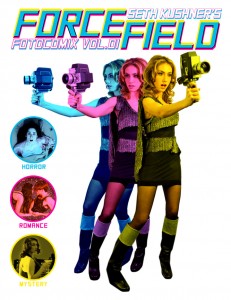
Then there’s FORCEFIELD FOTOCOMIX, which makes you feel guilty for all of that instinctual caution and pre-emptive wariness. It gives you what no one really dares expect or demand from photocomix, a team of seriously talented individuals on a mission to exploit the full potential of the medium. To do this, they decide to spin this collection of comics into a number of genres, covering all the bases and it’s as if they are illustrating future directions for photocomix.
The man behind the camera, someone whose work has defined “serious” photography of the cultural zeitgeist in the past decade and then some, is Seth Kushner, the co-creator of the celebration of comics tradition LEAPING TALL BUILDINGS with Christopher Irving. Kushner’s photo portraits of comics creators in LEAPING TALL BUILDINGS have garnered so much attention that they’ve been scavenged by internet sites repeatedly and Neil Gaiman even chose to use Kushner’s portrait of him as his new dust-jacket image. He’s been working on photocomix for some time now, creating a CulturePOP series for the digital arts salon TRIP CITY, profiling real lives in comics format from author Jonathan Ames to adult film star Stoya, but FORCEFIELD is a departure into the realm of total composition in fictional realities.

During an informal conversation at Hang Dai Studios, where Kushner keeps a tidy computer work station flanked by a few vinyl and action figures, he revealed some of the process behind his striking cover to FORCE FIELD. He staged a full-on photo-shoot to capture the images in his mind by engaging actress Zoe Sloan, as well as a costume designer and a makeup artist, to create a Barbarella homage fused with a direct design reference to a Jim Steranko cover of BLADE RUNNER from Marvel Comics. The Steranko cover, which uses multiple color reduplications of the hero pointing a gun, inspired Kushner to pose Sloan holding, instead, a Super 8 camera in retro style. The metaphor’s impressive: Kushner’s camera is a loaded weapon at the center of the strange narratives contained in FORCEFIELD, capable of directing the reader’s experience, and by using a Super 8 video camera rather than simply a camera, he’s suggesting the role of storytelling.
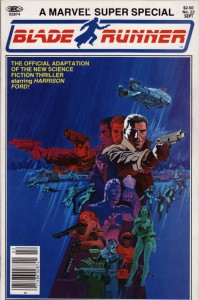
Kushner’s increasingly open these days to revealing the process behind his work to generate enthusiasm for the forms themselves and encourage others to experiment, as evinced by his recent contribution to TRIP CITY, a blow-by-blow narrative of the steps by which the first comic in the collection, “The Hall of Just Us”, called “Anatomy of a Photocomic”. The story, co-scripted by Emmy Award winning artist Dean Haspiel, led to its own formal photoshoot at the recently hurricane decimated by increasingly resilient Sunny’s Bar in Red Hook. Kushner and Haspiel set about “casting the roles, as we would for a film”, says Kushner, and the co-creators drafted full layouts for the comic before shooting, giving them a “map to follow”.
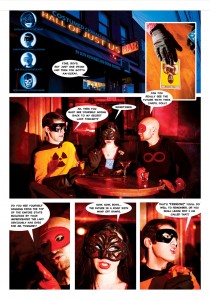
They created the comic shot for shot, a tale of three “miscreants”, superheroes in a bar chasing a super-powered lady’s attentions, “The Tarot”. After the shoot, time-consuming photo-shopping and comics construction added text, word balloons, and special effects. But all of this description only hints at the visual impact of “The Hall of Just Us”. It’s all about mood, created from strongly color-themed lighting (the pink, blue, and yellow of the cover’s design), and about the off-beat simple hero costumes straight off of Mego action figures or the BATMAN television show of the ‘60’s.
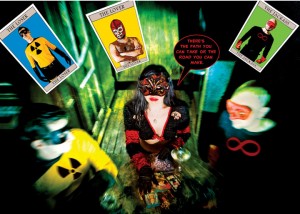
While the heroes posture and ratchet up the bombast, The Tarot figure, portrayed by model and artist Katelan Foisy, brings an eerie presence and substance to the narrative. She can see the future “sometimes” and sees the other heroes as Tarot figures, commenting “There’s the path you can take or the road you can make”, but she’s really calmly waiting for her “date” known as Señor Amore, portrayed by Haspiel. This is certainly the “romance” genre promised by the cover as one narrative alternative, but it leaves room for reader-interpretation. Superheroes with super powers are still hanging out in a bar, looking for love, for one thing.
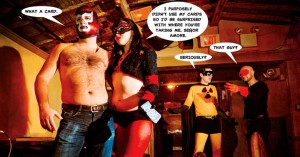
“Spiders Everywhere” provides the “horror” also promised by the cover, and again homage to genre comics and films is evident. The narrative and premises are simple- horrific waves of spiders taking over the world, but Kushner plays to the strengths of the photocomix medium by conveying frantic movements and moments of psychological realization in cinematic style.
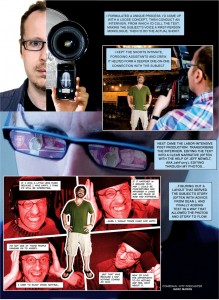
“Understanding Photocomix”, a visual walk through Kushner’s history with photography and photocomix, which first appeared in American Photo Magazine, supplies the metadata on the very form in which its composed. It also forms a clever narrative bridge between the first chapters of FORCEFIELD and its follow up chapter COMPLEX, by explaining Kushner’s increasing drive to push the boundaries of photocomix in a “full fictionalized graphic novel” that he’d “direct like a movie using actors and locations”. In many ways, FORCEFIELD is the herald of that process, and it’s Volume number “.01” suggests that it’s a forerunner of bigger things to come.
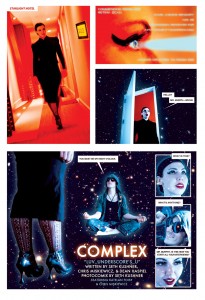
The story COMPLEX: “Luv_Underscores_U”, kicking off Kushner’s work on his dream project of the COMPLEX graphic novel, first appeared in Jimmy Palmiotti’s CREATOR OWNED HEROES #7 alongside Kushner and Irving’s ongoing profiles of indie comics creators (a follow-up project to LEAPING TALL BUILDINGS). It’s a lavishly shot and designed comic which plunges into science-fiction BLADE RUNNER style, another link to FORCEFIELD’s cover image. It constructs multiple virtual realities visually with ethereal attention to detail and emphasizes a governing psychological perspective, a central character keeping all these virtual worlds in motion for the reader. This isn’t far from the role of the camera itself seeming to direct the reader, perhaps FORCEFIELD’s hypothetical Super 8 on the cover itself.
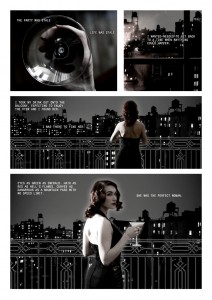
The final chapter of FORCEFIELD, a never before published noir tale, “The Perfect Woman” appears in uncharacteristic emphasis on black and white tones, with hints of color. Kushner’s photography is known for its psychedelic presentation of color through light effects, but also for his more sepulchral, moody hues in portraiture. Here he does with black what he often does with a solid color, making it a rich compositional basis into which he incises featured characters and settings. Like a compelling dime store novel rich with noir tropes, the story pursues an elusive lady in a cityscape from the visual perspective of a narrator. Kushner’s locations for this shoot were clearly exacting, capturing a city of the 1930’s complete with architectural detail. But the reader should have expected that this is a collection of stories with an expicit BLADE RUNNER homage and technology and perception may play as strong a role as the romance of pursuit.This is the “mystery” genre, completing the triad of color themes and pulp homage.
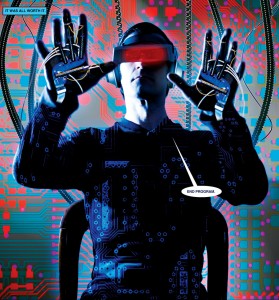
To add to the total design package that is FORCEFIELD FOTOCOMIX, it’s also presented in slick prestige magazine format with card covers, suggesting that photocomix can find their own effective dimensions for publication, in this case somewhere between a traditional comic and a traditional large-format photobook. But the format also speaks to Kushner’s consistent, passionate attention to detail throughout the collection which seems to constantly remind the reader of his fundamental belief in the art behind the form. The photocomix in FORCEFIELD are visually riveting, one might even say mind-altering, but the stories are also expansive, creating strange pocket universes with their own sets of rules and assumptions. Exploring them is part of the intrigue. Seeing FORCEFIELD in the wild is bound to make an impact on our assumptions about what photocomix have been, and more importantly, what they can be as a narrative medium in their own right. Kushner was inspired by comics, photography, and films to launch this project. In the future, creators might well be saying that they were inspired by FORCEFIELD to take photocomix in equally surprising and mesmerizing directions.

[Kushner answers, "What's the coolest item in your collection?" for Hanzarai.com]
FORCEFIELD FOTOCOMIX Vol.01 will be available for physical sale for the first time at the upcoming Asbury Park Comic Con March 30th, but the limited edition is already available for order through Kushner’s etsy shop.
Title: Seth Kushner’s FORCEFIELD FOTOCOMIX Vol.01/Publisher: Self-Published/Creative Team: Photographer, Seth Kushner/ Design, Seth Kushner and Dean Haspiel/ Writers, Seth Kushner, Dean Haspiel, Chris Miskiewicz/ Edits by Dean Haspiel
Hannah Means-Shannon writes and blogs about comics for TRIP CITY and Sequart.org and is currently working on books about Neil Gaiman and Alan Moore for Sequart. She is @hannahmenzies on Twitter and hannahmenziesblog on WordPress.

By:
Heidi MacDonald,
on 3/6/2013
Blog:
PW -The Beat
(
Login to Add to MyJacketFlap)
JacketFlap tags:
News,
Events,
Indies,
Webcomics,
Dean Haspiel,
Tails,
Image Comics,
Laura Lee Gulledge,
Page by Paige,
Top News,
Trip City,
Christopher Irving,
ACTIVATEcomix,
Autobiographical Comics,
Billy Dogma,
Bob Fingerman,
Ethan Young,
Housing Works,
Maximum Minimum Wage,
Streetcode,
Will and Whit,
Comics,
Benefits,
Image,
Add a tag
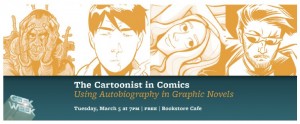
Autobiographical comics used to be a feature of zines and small private presses, but readers are increasingly able to follow their favorite genre of the comics medium in graphic novel editions from mainstream book publishers. There’s no doubt that the artistic appreciation for autobiography and semi-autobiographical works is on the rise, but amid commentary on layouts, designs, and narrative choices, it’s easy to lose touch with the personalities behind the works and the often difficult waters they navigate to create their comics. At Housing Works Bookstore and Café in Soho, part of the Housing Works charitable organization benefitting those affected by HIV/AIDS and homelessness, four cartoonists weighed in on their life in comics on March 5th in a panel hosted by comics scholar and author Christopher Irving (LEAPING TALL BUILDINGS, GraphicNYC). The event formed part of “Geek Week” at Housing Works, with copies of speakers’ books donated by publishers for sale to support the charitable organization.
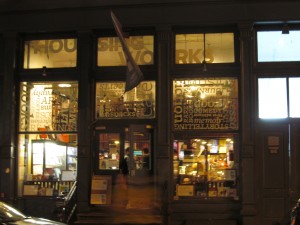
Panelists included Dean Haspiel (BILLY DOGMA, CUBA: MY REVOLUTION), Bob Fingerman (MAXIMUM MINIMUM WAGE, FROM THE ASHES), Laura Lee Gulledge (PAGE BY PAIGE, WILL AND WHIT), and Ethan Young (TAILS) and featured projected slides of their artwork along with readings, commentary, and discussion. Haspiel read “Dumbo” from his STREETCODE series, a tale of extensive personal injury after being “busted” as a thief by an overzealous and perplexed local driver during a film-shoot in Brooklyn and Fingerman read from an unpublished script of issue #11 of his acclaimed MAXIMUM MINIMUM WAGE series (which will appear in the new deluxe edition coming from Image March 20th) about the trials and tribulations of negative reviews and the dubious creative credits of working for “porno mags”. Gulledge, too, presented previously unseen material from her upcoming (in March) new book WILL and WHIT dealing with the stresses and awkwardness of teen life pursuing artistic expression, while Young read from his series TAILS, featuring cultural and familial clashes over relationships, but also noted that a second printed volume of the previously online series TAILS will be coming soon from Hermes Press.
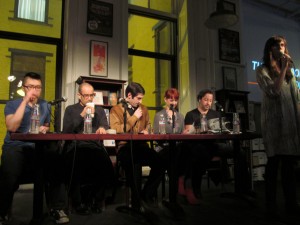
Each of the cartoonists presenting their work engaged the audience on an emotional level in different ways, showcasing the versatility that makes autobiographical comics so popular. Haspiel’s comic narrated the already inherently absurd scenario of playing a thug in a friend’s film being chased by a costumed superhero an the equally absurd but downright serious impact of being mistaken for a real thief and being mown down by a would-be vigilante on set. Haspiel’s “DUMBO” focused on the psychological shock and mental processes handling the bizarre, and all too physically real situation.
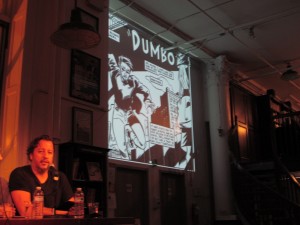
Fingerman’s script handled his experiences working for a “rag” magazine in semi-autobiographical fashion through his avatar “Rob”, with an ear for frank and surprising dialogue between Rob and former co-workers on the subject of a bad review of his comics issued by a replacement writer in Rob’s own former column on the magazine. Through Rob’s dialogue, the audience could hear the character’s increasing fixation and personal struggle with the affront, while other characters commented irreverently on his overblown reactions. The emotions of the situation were powerful, even while comedic in tone.
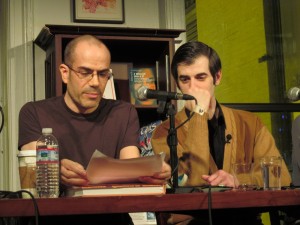
Gulledge’s selection from WILL and WHIT used limited but realistic dialogue between friends to tease out the tensions in young adult conversations, anxiety in public performances (in this case a puppet show) and the supportive, but complicated role of group friendships. While Haspiel and Fingerman handled subject matter that may have been unfamiliar to many readers, but connected on the level of universal reactions to antagonizing situations, Gulledge presented a universal situation and explored it through the lens of different personality types.
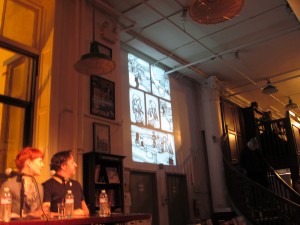
Young’s performance dealt with two major universal themes, family pressures and romantic relationships, but introduced the complicating factor of cultural divides as his character (also named Ethan) engaged in “blunt” conversations with his mother, translated from Cantonese into English, about whether dating a Chinese-American girlfriend was really the right thing for him. Each comics artist preserved a kernel of universal human experience in their works while bringing intricate detail of personal experience into the narrative to render it unique, compelling, and even more visceral. Experiencing the comics as performance, read by their creators, brought an added dimension of reality to the stories. Autobio comics readers often become fans of the “voice” of the cartoonist and feel that they almost know the author/artist personally, but this was a rare chance to hear the comic audibly and experience the comic visually with creator participation.
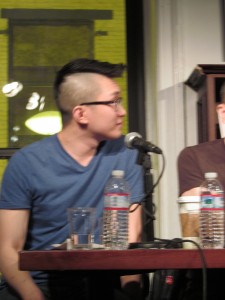
Christopher Irving took the opportunity to play readers advocate and encourage the panelists to explain how autobiography maps out the gray areas between art and life, asking what the relationship is, exactly, between these creators and their comic avatars. Gulledge explained that her characters are often “different variations” of sides of her personality, and in one of the most memorable phrases from the evening explained that portraying versions of herself in comics encourages her to take risks in expression, making her willing to “drop the baby” being thrown at her if necessary. The allusion was to a situation wherein street urchins might attempt to pick your pocket by throwing a doll at you, pretending it’s a real baby, in the hopes that you’ll be distracted enough to attempt to catch it. “Drop the baby” made for an excellent metaphor for autobiographical cartooning when the creator has to realize the difference between art and real life and take greater risks based on that truth.

Fingerman commented, to the audience’s amusement, that he would “gladly drop a baby”. His reasons for using an avatar named “Rob” rather than his own name, Bob, in MAXIMUM MINUMUM WAGE involved shying away from direct “narcissism” while keeping a certain “weight” of truth alongside the “latitude” for some fictionalization. Like Stephen Colbert’s concept of “truthiness”, he said, his comics get closer to the truth by allowing more freedom of expression than strict autobiography. He also added that after ten years of reflection on MAXIMUM MINIMUM WAGE and working on the new hardcover edition from Image , however, he’s “seriously thinking of coming back to the series and starting it up again”, which provoked a round of enthusiastic applause from the audience.
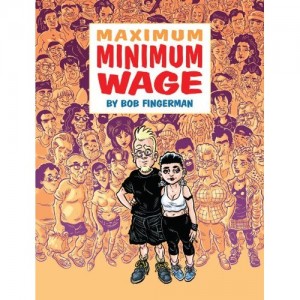
Haspiel’s own feelings about the difference between autobiographical and semi-autobiographical comics, two genres he has worked with extensively, pivot on his concern that autobiographical comics only allow the reader to act as “voyeur” in someone else’s life. Like Fingerman, Haspiel reflected on the fact that semi-autobiographical narratives enable the creator to zero-in on “emotional truths” that they might not be able to emphasize as fully when sticking purely to facts. His advice to autobiographical or semi-autobiographical cartoonists, generally, is to “get outside” and experience life, making sure you “show up to the party” that is life and take part in order to create compelling stories. Gulledge chimed in that she agreed with Haspiel and Fingerman, that even autobiographical comics are not about the cartoonists life in terms of their purpose, but are about “helping” the reader understand themselves by engaging with real-life situations.
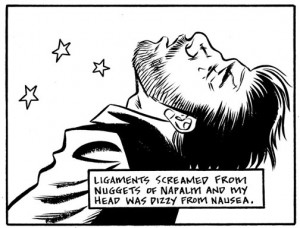
[Image from STREETCODE's "Dumbo" by Haspiel]
Young explained that he feels that his life can, in some ways, seem stereotypical, including his Asian-American heritage, emphasis on city narratives, his real-life situation of quitting college, and even being “self-indulgent” in writing stories designed to “get even” with an ex-girlfriend. But having a relatable life is certainly not a hindrance in autobiographical comics, especially when you capture the “romance” you see in the ordinary. Young hopes to “capture” some truths from his life in a memorable way, such as “living really broke” and “being single in New York”, experiences many readers might share. The most problematic thing Young has faced, he said, about working in autobiographical comics, is that readers equate the Ethan of his comics with Ethan in real life and feel free to tell him that he’s an “asshole” on a regular basis. He’s also been questioned for bringing “fantastic elements” into his works despite their overtly “realistic” tone, and like Haspiel and Fingerman, Young thinks a “metaphorical” element helps him “comment on how interconnected we are with our creations”. It seemed part and parcel of artistic freedom to branch from autobiography into metaphor for several of the panelists.
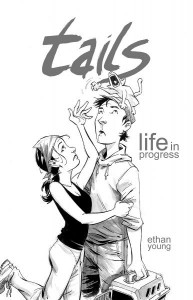
The discussion between comics artists on the panel was often freeform and interactive during the event, and they chatted about the increasing role of images online, the freedom the internet offers in terms of self-publication, and the impact that it has had on autobiographical comic production. Haspiel commented on the ways that social media has become a form of autobiographical expression, leading him further down the road of embracing metaphor rather than strict biography in his work. Even Gulledge expressed her movement toward “boiling down” life experiences to get to what life is “really about” due to the comparison between unedited and immediate self-expression on social platforms. Haspiel also noted, however, that social media opens up publicity options for web-based work, as in the case of ACTIVATEcomix, which he founded in 2006, and his currently curated multimedia arts site TRIP CITY. The very same technology that raises questions about autobiography by presenting human experience in an unfiltered way can serve as the platform for promoting the more focused works of art that reflect on life’s truths. One of the final topics of the evening focused on advice for cartoonists about funding and publishing their autobiographical and semi-autobiographical works. Now, more than ever, Haspiel argued for the need to be “be part of a community”, whether seeking crowd-funding or readership.

It was clear from hearing the panelists in discussion that they do form their own community of creators supporting many of the same goals in comics, and that each of them has a specific commitment to their readership in creating their work. The fact that the event spotlighting “the cartoonist in comics” not only benefited the comics community by exploring the role of biography and providing insights into creative process, but also raised funds for a worthy local charity emphasized the reciprocal role of community in supporting artwork about the significant truths hidden in everyday life and improving “real life” for those in need. The event was live-streamed by Housing Works and may be available in video format soon.
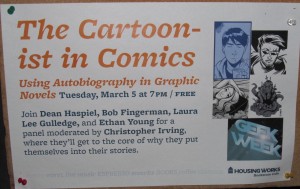
Hannah Means-Shannon writes and blogs about comics for TRIP CITY and Sequart.org and is currently working on books about Neil Gaiman and Alan Moore for Sequart. She is @hannahmenzies on Twitter and hannahmenziesblog on WordPress.

By:
Heidi MacDonald,
on 12/8/2012
Blog:
PW -The Beat
(
Login to Add to MyJacketFlap)
JacketFlap tags:
Reviews,
Comics,
Image,
Dean Haspiel,
Scott Morse,
Evan Dorkin,
Darwyn Cooke,
justin gray,
Indie Comics,
Jimmy Palmiotti,
COMPLEX,
Chris Miskiewicz,
seth kushner,
Top Comics,
Jeffrey Burandt,
"Blood and Brains",
"KillSwitch",
"Meatbag",
"The Deadly Book",
Brandon Seifert,
Christopher Irving,
Creator Owned Heroes,
Creator Owned Heroes #7,
Jerry Lando,
Paul Mountis,
Steve Niles,
Add a tag
Earlier this week, Jimmy Palmiotti announced that the noble experiment CREATOR OWNED HEROES would conclude after its 8th issue. Over the course of the magazine’s publication, outreach on social media emphasized the need to raise awareness and increase solicitation from comic shops to keep the multi-contributor series in motion. Consistently strong reviews appeared on media, fan, and blog sites with each issue, and as COH developed, it continued to raise the bar on high-quality content. The ascent has been dizzying, and exhilarating for readers and comics creators alike in an era of increasing awareness about the ups and downs of self-publication. It has been like watching crucial surgery in a live operating theatre in the hands of celebrated practitioners where the audience has come to play an integral role. The life of the patient has depended on their rapt attention in increasing numbers. Depending on your perspective, issue #8 will represent the final bow of an effort exploratory and unique, or perhaps somber flat-lining during a risky procedure that practitioners will attempt to learn from for some time to come. But either way, COH won’t be concluding in obscurity. Ironically, there will be more people in the operating theatre than ever before to witness its final moments and draw their own conclusions.
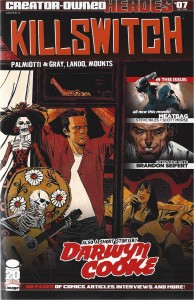
CREATOR OWNED HEROES #7 represents a particular crescendo in the magazine’s development, a point at which even those who have been following the series closely lean forward, aware that something unprecedented is unfolding before their eyes. It expresses a remarkable energy and a confluence of its methods and its goals due, in part, to the team of contributors it brings together. As Justin Gray says introducing his Brandon Seifert interview, “When we started Creator Owned Heroes, it wasn’t just a desire to self-publish; it was a multilevel dedication to comics that were being produced outside the work for hire landscape”. Gray also cites “ a fundamental desire to tell stories” as a common feature among the creators chosen as contributors. Issue #7 is a tour de force illustration of those criteria.
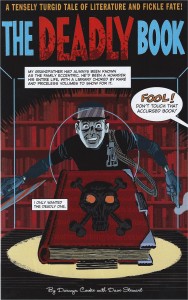
The powerhouse comic in the anthology is clearly Darwyn Cooke’s irreverent, rapidly paced and verbally exuberant “The Deadly Book”. Cooke hits high notes across the board of comic storytelling elements, from a lush, contrasty color palette in sky-blue, blood-red, and ink-black, to unexpected vantage points, compressed action, and even a very indie take on relating past events in short form via substantial narrative blocks. The comic displays the best possible outcomes for a skilled creator taken off the leash to tell the kind of story that they want to tell in the way that they see fit to tell it.
Jimmy Palmiotti, Justin Gray, Jerry Lando, and Paul Mountis follow Cooke with “Killswitch” in its 3rd installment of 4. They put the action back in indie in a big way and display a particular virtuosity in reversing a typical paradigm in espionage/hitman themed comics. Rather than telling the story with several panels, if not pages, of heavy exposition followed by the action sequences readers have been waiting for, they manage to reveal a wealth of exposition during an installment that, arguably, is one big action arc. They keep it interesting by demanding the reader put the pieces of information together for themselves, from Kill Switch’s complicated pseudo family life to the developing role of a nemesis. Rather than just telling a story well, which is a quite an achievement in itself, they manage to tell a story differently, once again illustrating the surprising results when creators have sufficient room for experimentation.
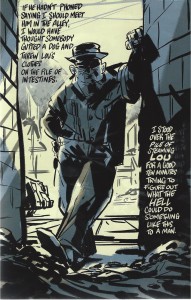
Steve Niles and Scott Morse bring an even greater variation in style and content to COH #7, pushing the boundaries of typical narrative structures while giving a nod to still-rich veins of comics tradition. They break down confined panel layout, and do away with textboxes and speech balloons to tell a noirish private-eye tale with disturbing gusto. “Meatbag’s” full page-feel conjures up Eisner’s SPIRIT while the first-person narrator places the storytelling firmly in Raymond Chandler territory. Add to these elements the use of limited color palette, heavy brush-stroke illustration and moody lettering, and you’ve got a finely balanced combination of old and new, making this a 21st century comic with a lot of room for innovation.
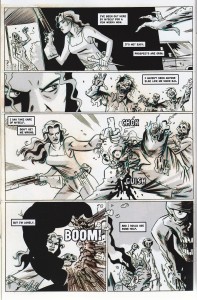
Then we have zombies. The subject-matter is in danger of being done into the ground in the TV, film, and comics medium, but in keeping with the challenges set by COH #7, Dean Haspiel and Jeffrey Burandt deliver something readers have simply never seen before, imploding any expectation of the familiar. Haspiel’s zombie artwork avoids the basic emphasis on blood and gore flooding zombie media these days and emphasizes, in a visceral way, the disjointedness of decomposition through trailing limbs and chunks of missing anatomy. This makes Haspiel and Burandt’s heroine seem all that much more solid, active, and vital as she spikes a zombie noggin and blasts through zombie brains. This is zombie-storytelling streamlined to basic psychological elements: loneliness, companionship, and, finally, the pulse-poundingly unexpected that makes the genre so popular. “Blood and Brains” retools zombie narrative by removing excess accretion and celebrating its potential in creator-owned style.
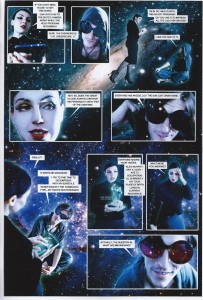
Photo-comic COMPLEX: “Luv_Underscore’s_U” by Seth Kushner, Chris Miskiewicz, and Dean Haspiel reminds us that the comics medium is expansive, varied, and should never feel too comfortable. Katelan Foisy and Miskiewicz star in this futuristic psychological landscape where the solid realities of the photo images help readers keep a grip on the otherwise shifting definitions of reality in the narrative. There’s a subtle ambiguity in the nature and future of technology, it’s use and misuse to contribute to human experience, and on the whole the photo-comic not only tells the reader but shows the reader the spell-like suspension of disbelief comics, in the right hands, are still capable of creating.
The prose content of COH #7 also contributes greatly to the purpose of the series, present from issue #1, of taking readers inside the world of creator-owned projects, an on the ground approach that not only educates but instructs. Justin Gray’s interview with Brandon Seifert allows the reader to hear straight from the horse’s mouth, “Want to be a writer? Start writing. It’s that simple, and that hard”. A “social media press conference” included in the issue also brings together advice and insight from creators and Steve Bunche concludes a full-on bootcamp for aspiring comics writers with plenty of solid advice that may seem counter-intuitive like “avoid topical subjects”. It’s clear that the meta-text of COH #7 is not there simply to sell books but to actually aid aspiring creators in avoiding the pitfalls that contributors have faced.
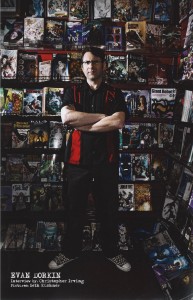
From issue #1, COH has given a strong impression of community among indie creators, and #7 continues to follow through in inclusiveness. A major profile of legendary tide-fighter Evan Dorkin, written by Christopher Irving, and photographed by Seth Kushner, only further illustrates the point. Creator-owned projects may seem like a new thing, maybe even a fad, but they aren’t. They’ve been breaking new ground for some time, and there’s plenty to be learned from observing the struggles of greats like Dorkin. Dorkin’s legacy in brief could be summed up in his statement: “I’ve come to hate when people say ‘Don’t get into comics’. I learned to say ‘Fuck that. If you want to get into comics, get into comics’”. But Dorkin, like many other creators, is also prepared to try to inform readers about what exactly they are getting into because a few tips a long the way can make all the difference.
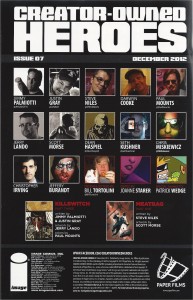
The combined tone and attitude of the comics and prose in CREATOR OWNED HEROES #7 avoids even the faintest whiff of defeatism. The series’ message is still going strong, and the works it presents don’t even aspire to meet the professionalism of company-owned comics, they aspire to go beyond company-owned projects in terms of high-quality story-telling, artwork and design. After all, what’s the point in trying to keep up with the Joneses when you really want to set a new standard all your own? As an experiment, the COH series is winding down, but the data is being collected, the procedure is nearly complete, and no one doubts the skill of the team involved. The increasing momentum generated in the pages of COH #7 has, certainly, guaranteed that no one will stop reading until the experiment is complete.
Hannah Means-Shannon writes and blogs about comics for TRIP CITY and Sequart.org and is currently working on books about Neil Gaiman and Alan Moore for Sequart. She is @hannahmenzies on Twitter and hannahmenziesblog on WordPress.



































This looks great. Stunning actually, but at $10? Ouch. I realize the cost of making something like this is a lot, but at only 32 pages… It’s going to be a novelty item only till they can bring the price tag down. If this was $6, its a much easier buy.
[...] The Beat – Forcefield Fotocomix #.01 [...]